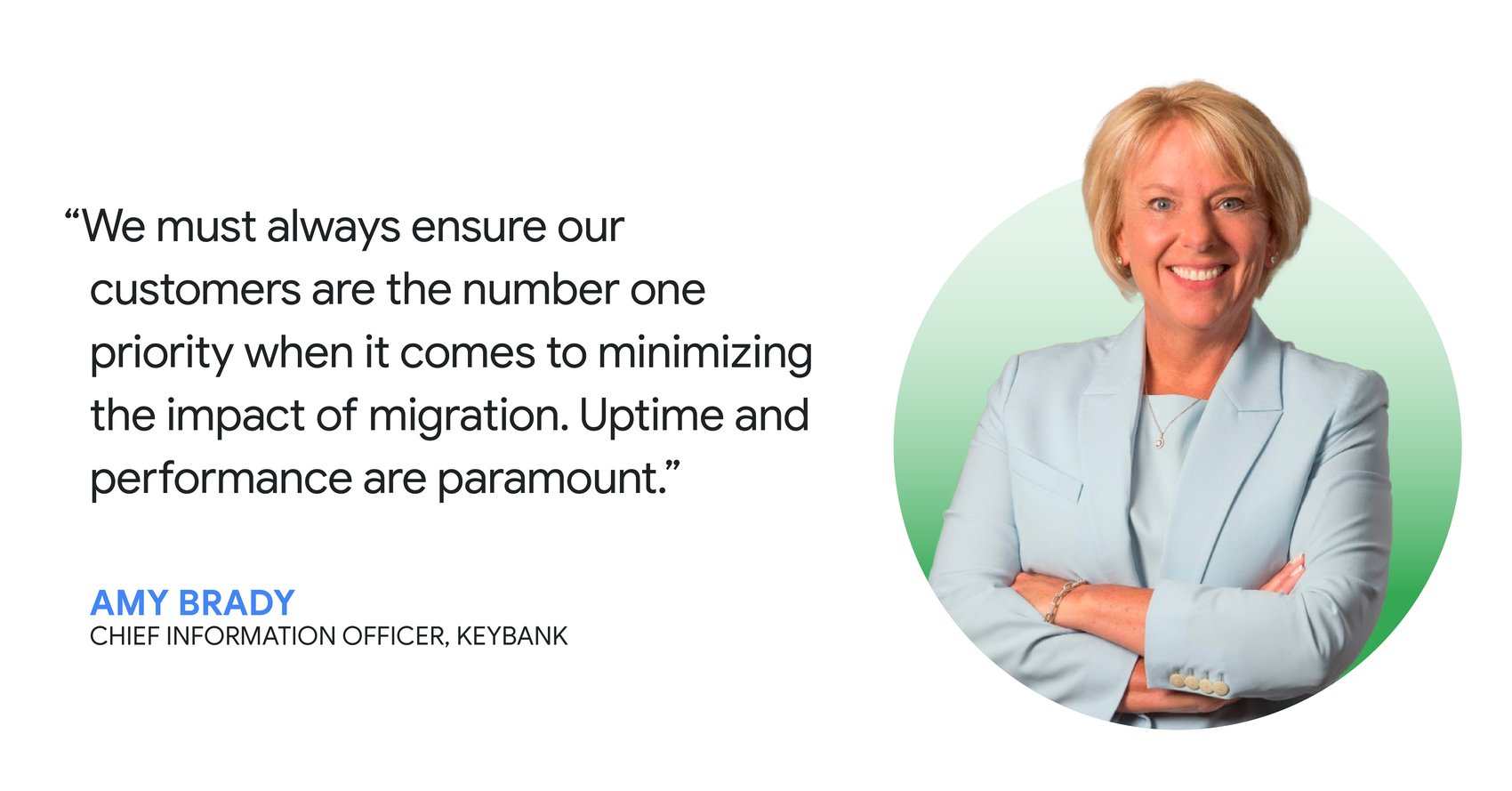The future of industries: What's happening now and next in financial services – with KeyBank

Yolande Piazza
VP, Financial Services, Google Cloud
Amy Brady, chief information officer at KeyBank, discusses the substantial business impact of the bank's strategic cloud migration
The need for enhanced agility, scalability, and cost-efficiency have been driving a transformative shift in the banking industry as financial institutions increasingly deploy cloud-based applications. Cloud technology allows banks to innovate rapidly, respond to market changes, and meet the evolving expectations of digitally savvy customers.
KeyBank’s cloud journey showcases the strategic, security-focused approach necessary for successful cloud adoption in the financial sector.
The Cleveland-based financial institution has achieved significant milestones, realized substantial business benefits, and learned valuable lessons that can guide other financial institutions as they focus on creating better experiences for customers and employees. As the cloud technology landscape evolves, KeyBank continues to innovate and leverage new capabilities to enhance client experiences and operational efficiency.
“Our cloud strategy is driven by a core business case that demonstrated impact over a relatively short period of time,” Amy Brady, Chief Information Officer at KeyBank, explains.


Today, KeyBank’s cloud strategy has been instrumental in modernizing the bank’s technology ecosystem, enhancing security, and preparing for future business initiatives.
In a recent interview, Brady discussed the bank’s strategic approach to cloud adoption with Yolande Piazza, vice president for financial services at Google Cloud. As an early adopter of cloud technology in the banking sector, KeyBank has seen the evolving opportunities of the cloud first hand. To illuminate this evolution, Brady shares Key Banks’ strategy, key milestones, lessons learned from its journey, and where she sees the industry’s technology going next.
Yolande Piazza: We started our cloud journey together almost a decade ago. What prompted KeyBank to adopt a cloud strategy, and what were the primary business objectives?
Amy Brady: KeyBank recognized the potential of cloud technology early on and approached it with a strategic mindset. Our main goals were to accelerate business and technology goals, improve cycle times for implementing new services, enhance security, and modernize our technology ecosystem. The business case was clear: efficiency, modernization, and enhanced security were pivotal.
Our strategy included migrating a significant portion of our applications to the cloud. Once we achieve our goals, this will set us up for the future and provide the scalability we need to expand our capabilities. We especially like how Google Cloud’s state-of-the-art tools help us better serve our clients and our employees. It’s helped us accelerate the adoption of technology across our ecosystem while enriching user and client experiences.
Our strategy included migrating a significant portion of our applications to the cloud. Once we achieve our goals, this will set us up for the future and provide the scalability we need.
What were some critical milestones in KeyBank’s cloud journey?
The journey started with migrating our data to Google Cloud, driven by the need to avoid the increasing demand for additional hardware to scale and to meet the need for analytics and data use across our enterprise. Successfully moving all our data, including customer data, was a significant milestone.
We migrated using a phased approach with a tremendous focus on performance, resiliency, and security. We recently completed our seventh “wave,” which included our online banking portal – our most active channel for customers to interact with us and conduct their business – and our online origination system.
This year alone, we’ve migrated more than 75 applications to Google Cloud, and by the end of the year, we plan to move another 100 applications. Another key milestone will be our contact center migration, which we aim to complete by late in Q3 2024.
It sounds like you’ve tackled a lot. What are some lessons that other financial institutions might benefit from?
Firstly, we must always ensure our customers are the number one priority when it comes to minimizing the impact of migration. Uptime and performance are paramount. We also realized the importance of not forcing the cloud migration of applications that aren’t ready for it. Some applications may need re-architecting to fully leverage their cloud benefits.
With this in mind, several key lessons stand out:
- Start with security. You should establish a solid target-state security framework from the beginning. We made it fun by creating a security stop-gate called “Ticket to Ride.”
- Implement strong financial operations. It’s important to monitor and manage cloud costs to avoid unexpected expenses. Don’t assume the cloud will reduce or increase costs, as other forces may be at play.
- Control access. Your organization needs to ensure strong access management practices throughout the migration process to avoid any security remediation later in the process.
- Upskill your employees. Your migration can do double duty as an opportunity to train and upskill your team. Our “Future Ready” program provides engaging cloud learning journeys.
- Be realistic. Sometimes, our enthusiasm takes charge of pragmatism. Use a phased rather than a “big bang” migration approach to ensure more success and fewer risks.
These practices continue to give us confidence in our ability to continue migrating the next wave of applications benefiting our customers and teams.
Can you quantify some of the business benefits KeyBank has realized from the cloud migration?
We’ve observed incremental performance improvements and cost efficiencies. For instance, our online banking now benefits from cloud-native services, which reduce costs for us and enhance performance. Response times are faster and we’re now able to safely deploy new capabilities for our customers through our modern deployment pipelines.
The migration has also reduced the maintenance burden on our engineers, allowing them to focus on new features and innovations. Overall, we expect continued improvements as more applications move to the cloud.
Security was something many banks focused on in the early days of cloud, given the perceived, if unrealized, risks. How did KeyBank ensure its security and mitigate any concerns?
Security has been a top priority from the start. We developed a comprehensive security framework and a system we called “Ticket to Ride," in which applications had to be thoroughly tested and meet security standards before they could be migrated to the cloud. This approach paid off, as we’ve seen improved performance and faster customer response times. This is an area where we regularly leaned on Google Cloud’s support to help us evaluate and enhance our security posture.
Security has been a top priority from the start. We developed a comprehensive security system called 'Ticket to Ride', in which applications had to be thoroughly tested before they could be migrated.
With all of this in mind, why did KeyBank choose Google Cloud as its primary partner for this transformation?
I truly believe in win-win partnerships when you’re executing an enterprise technology strategy. Google Cloud stood out due to its robust native services, particularly in security and data analytics. We were early adopters of Anthos and Kubernetes when we started our digital journey with Google Cloud nearly 10 years ago. These services enabled us to take advantage of Google Cloud’s data and analytics capabilities as we migrated our data warehouse to BigQuery — which was a crucial tipping point in accelerating our transformation to work faster and smarter and meet client demand.
Just as important as Google Cloud’s technology is the opportunity to form a truly innovative partnership. The Google team was willing to listen to our needs, offer capabilities to meet those needs, and then innovate together in a cohesive and collaborative way.
With all KeyBank has already done, where do you foresee the future of cloud technology going in the financial services industry?
The future is bright for cloud technology, especially with advancements in AI and analytics. Financial services can significantly benefit from generative AI and advanced analytics to create customer value and manage risks. It’s crucial to have clean, well-managed data and to partner with cloud providers that can affordably and efficiently support high-compute needs. At the end of the day, it’s the combination of powerful tools and skilled experts that drive the best business outcomes.
What comes next for KeyBank on its cloud journey?
We will continue migrating applications, aiming to complete this work by 2025. New applications are being built directly on Google Cloud. We’re excited about leveraging Google Cloud’s data mining and analytics capabilities to gain faster, deeper insights, improve decision-making, and enhance our customer offerings. Our contact center migration is another critical focus for us, as we aim to provide a seamless omnichannel experience for our customers and better experiences for our agents.
Opening image created with MidJourney, running on Google Cloud, using the prompt: An upbeat flat illustration of a bank vault opening invitingly in the clouds.



